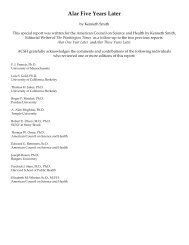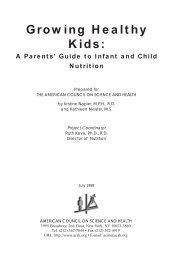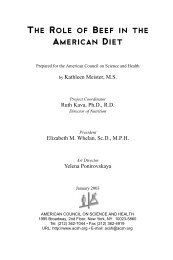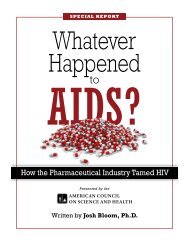View pdf - American Council on Science and Health
View pdf - American Council on Science and Health
View pdf - American Council on Science and Health
You also want an ePaper? Increase the reach of your titles
YUMPU automatically turns print PDFs into web optimized ePapers that Google loves.
eached your pers<strong>on</strong>al sun exposure limit, switch<br />
from your usual product to <strong>on</strong>e that gives you<br />
maximum protecti<strong>on</strong>—that is, a sunblock. These<br />
products typically c<strong>on</strong>tain compounds like titanium<br />
dioxide <strong>and</strong>/or zinc oxide. Remember that<br />
cocoa butter, baby oil, <strong>and</strong> mineral oil are not<br />
sunscreens <strong>and</strong> do not protect you from the sun’s<br />
rays.<br />
Tune in to your local weather channel to get<br />
advance notice of how intense the sun will be in<br />
your area—the UV index. The Nati<strong>on</strong>al Weather<br />
Service, in c<strong>on</strong>juncti<strong>on</strong> with the Envir<strong>on</strong>mental<br />
Protecti<strong>on</strong> Agency (EPA) <strong>and</strong> the Centers for<br />
Disease C<strong>on</strong>trol <strong>and</strong> Preventi<strong>on</strong> (CDC), developed<br />
this index. Essentially, the UV index takes<br />
into account the time of year, latitude, altitude,<br />
<strong>and</strong> forecasted amount of cloud cover to predict<br />
how much UV radiati<strong>on</strong> will reach the surface of<br />
the earth at no<strong>on</strong> <strong>on</strong> a given day. The index ranges<br />
from 0-10, with 10 being the most intense. The<br />
higher the index, the more important sunscreen<br />
use will be. Also, remember that the sun’s rays<br />
are most intense (at any index level) between 10<br />
a.m. <strong>and</strong> 4 p.m., so plan exposure accordingly.<br />
While a natural suntan helps to protect you from<br />
sunburn, it does not protect you from further<br />
damage from the sun’s ultraviolet rays.<br />
“Artificial” tans—those acquired from topical<br />
self-tanning creams—are equally unprotective.<br />
While the creams are safe for use, the <str<strong>on</strong>g>American</str<strong>on</strong>g><br />
Academy of Dermatology recommends applying<br />
them at least <strong>on</strong>e night before you plan to lie outside<br />
in the sun, <strong>and</strong> using sunscreen when you are<br />
exposed to the sun. (Note that tanning pills that<br />
are taken internally have been removed from the<br />
market <strong>and</strong> are illegal. The pills c<strong>on</strong>sist of huge<br />
doses of coloring materials comm<strong>on</strong>ly found in<br />
foods, such as carotenes. Although these pigments<br />
are safe when c<strong>on</strong>sumed in the small<br />
amounts present in food, they have not been<br />
shown to be safe when taken in doses large<br />
enough to discolor your skin.)<br />
Even if you never get sunburn at home, keep the sun in<br />
mind when you travel. In tropical regi<strong>on</strong>s, the sunlight<br />
is intense enough to burn almost every<strong>on</strong>e. The sun’s<br />
ultraviolet radiati<strong>on</strong> is also str<strong>on</strong>ger at higher altitudes.<br />
A few medicines can cause photosensitivity, making<br />
you more susceptible to the sun’s ultraviolet<br />
light; therefore, you are more likely to get sunburn.<br />
Examples of such compounds include some<br />
acne medicati<strong>on</strong>s, oral c<strong>on</strong>traceptives c<strong>on</strong>taining<br />
estrogen, tetracyclines, <strong>and</strong> sulfa drugs. Your<br />
doctor or pharmacist can inform you if a prescripti<strong>on</strong><br />
drug is likely to cause this problem.<br />
Although tanning parlors have been touted as the<br />
“safe way to get a tan,” their sun lamps do emit<br />
UV A radiati<strong>on</strong> <strong>and</strong> can cause l<strong>on</strong>g-term skin<br />
damage.<br />
C<strong>on</strong>sidering the l<strong>on</strong>g-term damage <strong>and</strong> cancer<br />
risk associated with extensive exposure to the<br />
sun, you might want to rec<strong>on</strong>sider cultivating a<br />
suntan. Many health authorities now recommend<br />
that people not attempt to tan at all. Perhaps it<br />
so<strong>on</strong> will be fashi<strong>on</strong>able to have healthy skin <strong>and</strong><br />
maintain normal skin color year-round rather<br />
than deliberately subjecting the skin to harmful<br />
ultraviolet radiati<strong>on</strong>.<br />
2<br />
Sunglass Savvy<br />
Sunglasses are not just a fashi<strong>on</strong> accessory. They<br />
can add greatly to your comfort if you choose the<br />
proper pair. Exotic lens colors may be stylish, but<br />
for real protecti<strong>on</strong> your best bet is plain gray, with<br />
green as a sec<strong>on</strong>d choice.<br />
Sunglasses should block 99 to 100% of UV A <strong>and</strong><br />
UV B radiati<strong>on</strong>; they should be labeled to so indicate.<br />
Over-exposure to UV radiati<strong>on</strong> increases the<br />
risk of cataract formati<strong>on</strong>.<br />
If glare is a problem, polarized sunglass lenses<br />
are a good choice. “Mirror” coated glass lenses,<br />
the type favored by skiers, also help to reduce<br />
glare since they screen out more light than tinted<br />
lenses.<br />
Sunglasses should not be worn at night. If you<br />
find it too inc<strong>on</strong>venient to remove your sunglasses<br />
at night, or when indoors, you may want to try<br />
light-sensitive or photochromic lenses, which










